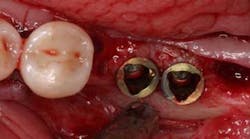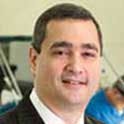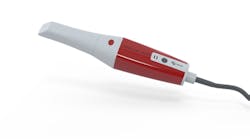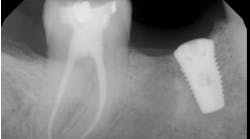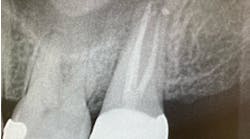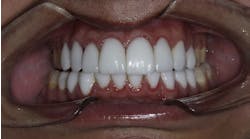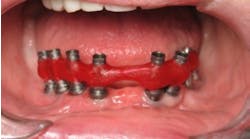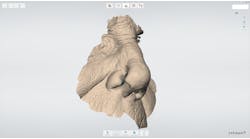Correcting malpositioned dental implants: Where do we go from here?
An unfortunate occurrence in dental implant prosthetics is malpositioned implant placement. In fact, a large percentage of my dental laboratory business has been restoring “rescue cases,” which are usually either new cases or remakes of seemingly unrestorable implants
ADDITIONAL READING | Diagnosing between ailing and failing implants: The haste to remove salvageable implants
There are various methods for restoring these prosthetic problems, one of which is the cementable option. The custom abutment dates back to the 1980s. This was directly related to poorly placed implants for which doctors had no possible means of restoring, due to a lack of angle-correcting abutments from manufacturers. We lab technicians had to find ways to make these cases work, such as making a custom abutment out of the titanium alloy impression coping for the Core-vent implant or using the UCLA abutment from Implant Innovations. The cementable option became the only one for many dentists due to their familiarity with standard crown and bridge and the lower cost. However, cementable restoration has come under fire in the last few years due to cement-induced peri-implantitis and other controversial claims. So in the case of a screw-retained prosthesis where the implants are malpositioned, we have quite a few options.
1. Premachined angled abutments work wonderfully for poorly angled, yet somewhat reasonably placed implants. A large span bridge with many implants where one or two will have the screws coming out of the buccal can be easily corrected. This applies only if the implant manufacturer makes angled correcting abutments. Nobel Biocare, Straumann Bone Level Implants, Biomet 3i, Zimmer, and a few more make these abutments. Simply place the abutment on the implant, aiming the screw hole to the lingual. Angle correction varies by implant manufacturer from 17–35 degrees. Premachined components attach over these abutments, allowing for precise fit and accurate screw retention versus a custom abutment style. The drawbacks to this system are:
- If the implant is too far buccally placed, the abutment will be too fat and out toward the cheek.
- If the implant is not deep enough, the abutment will show above the gum.
- The angle is based on the implant’s interface; therefore, in the case of Nobel Biocare Replace Select, the angle is based on one of the three tri-lobe points. If the flat part of the implant is in the buccal, the angled abutment will not go in the desired positon.
2. A custom abutment with a milled lingual screw hole is an option when the manufacturer does not make an abutment or the position is too buccal or too deep. In this situation, the custom abutment can be made in the traditional way as any cementable prosthesis with a labial chamfer or butt. After finishing the abutment, a lingual screw hole is tapped with a specific-sized tap that corresponds to a screw. A plastic waxing sleeve and screw is attached to the abutment, and an over-coping is waxed. When completed, the coping is now screw retained. The drawbacks to this system are:
- It is not premachined so if anything should happen in the future, the abutment must be removed to adjust the bridge. A premachined abutment can stay in the mouth and impression copings and analogs exist for remake or refurbish.
- Another issue is that the buccal-lingual dimension will, in most cases, be much thicker than desired due to the size of the abutment and the screw.
3. A milled mesio frame acts as one big custom abutment when all of the implants are malpositioned. A bar that attaches to all of the implants is made with either tapped occlusal or lingual screw holes. The bar, when placed in the mouth, will have the implant screw holes pointed in many different positions. In many cases, the cylinder and screw will be away from the bar. The one piece over frame will lay on top and be screwed into the mesio frame. The end result is a traditional-looking screw-retained bridge. The drawbacks of this system are:
- The frame is thicker and more space is needed for the restoration.
- The cost is much higher due to the fact that two frames are being made.
- The custom screw holes can wear away in the future.
4. An overdenture works in many cases. The angulation of the implant is not as crucial in an overdenture since the overdenture covers everything up. A clip bar acts in many ways like the mesio frame, except the overframe is removable by the patient and, in most cases, the overframe of a mesio bar is not. A one-piece solid bar with attachments—such as ERA, Locator, Hader, and many others—is made and a denture snaps onto it. Sometimes two separate bars are made if the implants are so nonparallel that a one-piece frame is impossible. Overdenture abutments come in handy in that they are individually placed and do not require a frame. Locator, ERA, GPS, and Equator are just some of the overdenture systems available. They also allow for angulation correction up to 45 degrees. The drawbacks of these systems are:
- The patient was told that a fixed case was being made and is now settling for a removable overdenture.
- Bar overdentures are not cheaper in cost from the lab and, in most cases, the dentists are not able to charge the patient a comparable price to the fixed case. (Locator cases are less expensive.)
- The denture is tissue supported and just gets the final lock from the attachments. This means that relines are in the future as well as visits for regular attachment replacement.
5. Screw holes coming out of the buccal are not the end of the world. In the posterior, the only ones really concerned about the screw holes are the dentist and the lab. The patient really has no expectation of where the holes are. Once filled with the composite, the case is done and the patient goes home—no wiser to the screw hole issue. Sometimes the implant is so far buccal that it comes out of the gingival-colored ceramics of the bridge. This comes out nicely since a pink plug in the gingival is more esthetic than on the mid-facial of an anterior. More than once I have had an implant that was so far labial that we made a screw-retained crown with the hole coming out of the gingival, and in essence made a lingual ridge lap crown. The drawbacks to this system are:
- Pride—dentists fear other dentists looking at their work in the future and criticizing the choice to let a hole come out of the buccal.
- This is not a great option for the anterior.
- In the case of the lingual ridge lap, you now have a less cleansable restoration that will require a lot of follow-up visits.
ADDITIONAL READING | A unique method of debriding a full-arch, maxillary prosthesis supported by dental implants
There are other methods to restore malpositioned implants. Probably the best one would be prevention and proper use of guided surgery prior to placing the implants. It is 2016 of the 21st century and “that’s where the bone was” is not an acceptable excuse anymore. If there is not enough bone, offer another option. Measuring twice and cutting once is an age-old adage that pertains 100% to implant placement. Software programs such as Simplant, NobelClinician, Implant Studio, coDiagnostiX, and many more exist to make sure more precise and predictable final restorations will be made.
ADDITIONAL READING | How a perfect, implant-retained anterior bridge can cause facial pain
Many think this applies only to full arch, but single tooth is probably the most important use for these guides. The difficulty in getting an esthetic, adequately supported proper emergence profile restoration on an anterior implant is without a doubt the hardest. Even using a surgical guide with pilot holes is not a 100% sure solution considering that once you begin drilling freehand, the drill can be tilted and now will be too labial, thus coming out of the incisal tip.
The team concept of oral surgeon, restoring dentist, and lab technicians is most crucial at the planning stages rather than the final restoration stage. By using scans and implant-placement software, we can preplan the final restoration and carry out our plan with no late surprises to the patient or restoring doctor as far as lab fees or final esthetics.
ALSO BY STEVEN PIGLIACELLI | The future of the dental lab industry: The lab industry ain't never gonna be the same
